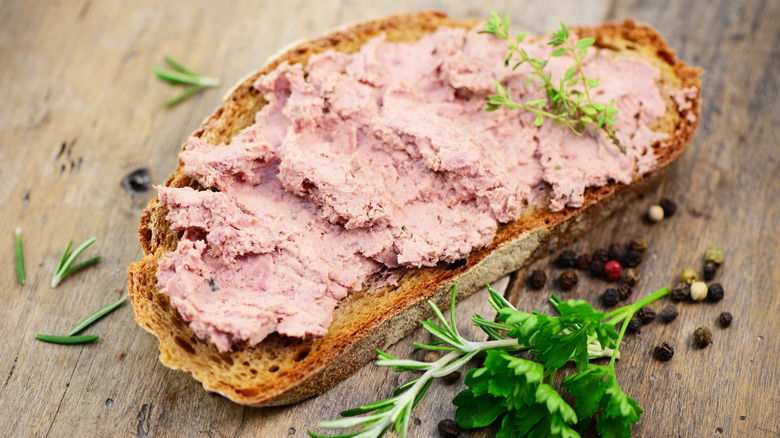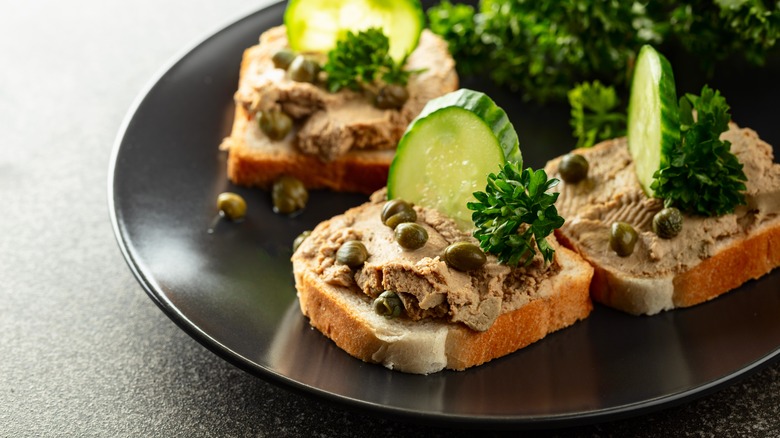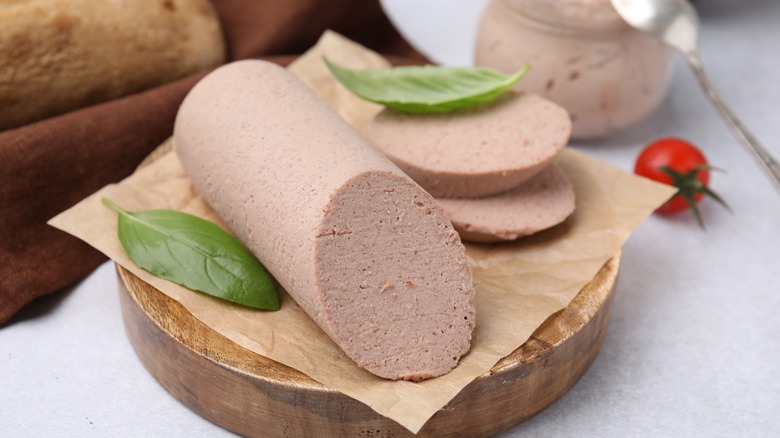Is Liverwurst The Same As Pâté?
If you're a fan of different kinds of cured meats, chances are you're familiar with liverwurst. The soft, robustly flavored sausage is made from ground meat, liver, fat, and seasonings, which are encased, cooked, and usually served with bread. This makes it sound rather a lot like its fancy French cousin, pâté, which is also often made with ground meat, fat, and seasonings that are cooked in a mold.
So, are the two things essentially the same? Well, no, not quite, though there are lots of similarities. Liverwurst contains a variety of meats (usually pork, beef, or veal) but must also include a minimum of 30 percent liver from pork, beef, veal, sheep, or goat. Pâté can also be made with all kinds of meats, as well as livers; poultry and game are particularly popular, with chicken liver pâté being a classic dinner party favorite.
Just as with the difference between pâté, terrine, and rillettes, what sets pâté and liverwurst apart also comes down to the texture and how they're served. Pâté is usually soft and spreadable with a paste-like consistency (the word means paste in French) and is typically an appetizer or party snack. Liver pâté is especially smooth. Liverwurst, meanwhile, can be sliced as well as spread, is commonly used as a sandwich filling or cold cut, and can also be used as an ingredient in other dishes.
Pâté comes in many different styles and serving options
Pâté can be made with different meats and, depending on the type, can be prepared and presented in various ways. Popular types include pâté de campagne, a country pâté made with pork, and pâté de foie gras, which is made from duck or goose liver. It can even be meat-free, with vegetables like mushrooms as the star ingredient, or made with fish such as smoked mackerel.
Pâté is commonly served in one of two ways: en terrine, which means it's cooked in a mold, or cooked within a flaky pastry crust, known as pâté en croûte. If you're making liver pâté with chicken or duck livers, a top tip is to soak them in buttermilk or milk overnight before cooking them, which helps remove the bitter metallic taste you sometimes get. Cook the pâté mixture gently in a water bath to prevent it from overcooking.
Although it's usually served cold or at room temperature with crusty bread or toast and cornichons to cut through the meatiness, pâté can sometimes be dished up hot — for example, spread onto toasted baguette slices or in bánh mì. Liver pâté is also often a key component in homemade beef Wellington, mixed with mushrooms and onions to add extra richness to the tasty meat and pastry combo.
Liverwurst can make a great addition to other dishes
Whether it's served in a sandwich or as part of a charcuterie board, liverwurst is arguably an old-fashioned dish that should make a return. And while it's not quite the same as pâté and doesn't have the same prestige as an elegant appetizer, you can actually make liver pâté from liverwurst. Simply mix the sausage with cream cheese, milk, onion, and seasonings and let it firm up in the fridge.
Liverwurst is often confused with braunschweiger, another type of German sausage, but the main difference is that braunschweiger is usually smoked, whereas liverwurst isn't. But in addition to being sliced into a sandwich, liverwurst and braunschweiger can also both be used as ingredients to enhance other recipes, from dips to potato hash.
A great way to serve liverwurst is to fry it, which gives it a crisper texture. It can be pan-fried or deep-fried, and the meaty pieces work well in everything from pasta salads to creamy casseroles. Or fry larger slices and serve them with a savory mushroom sauce for a hearty meal. Alternatively, you could incorporate some of the cooked sausage into meatballs, meatloaf, or burger patties to add a richer flavor.



